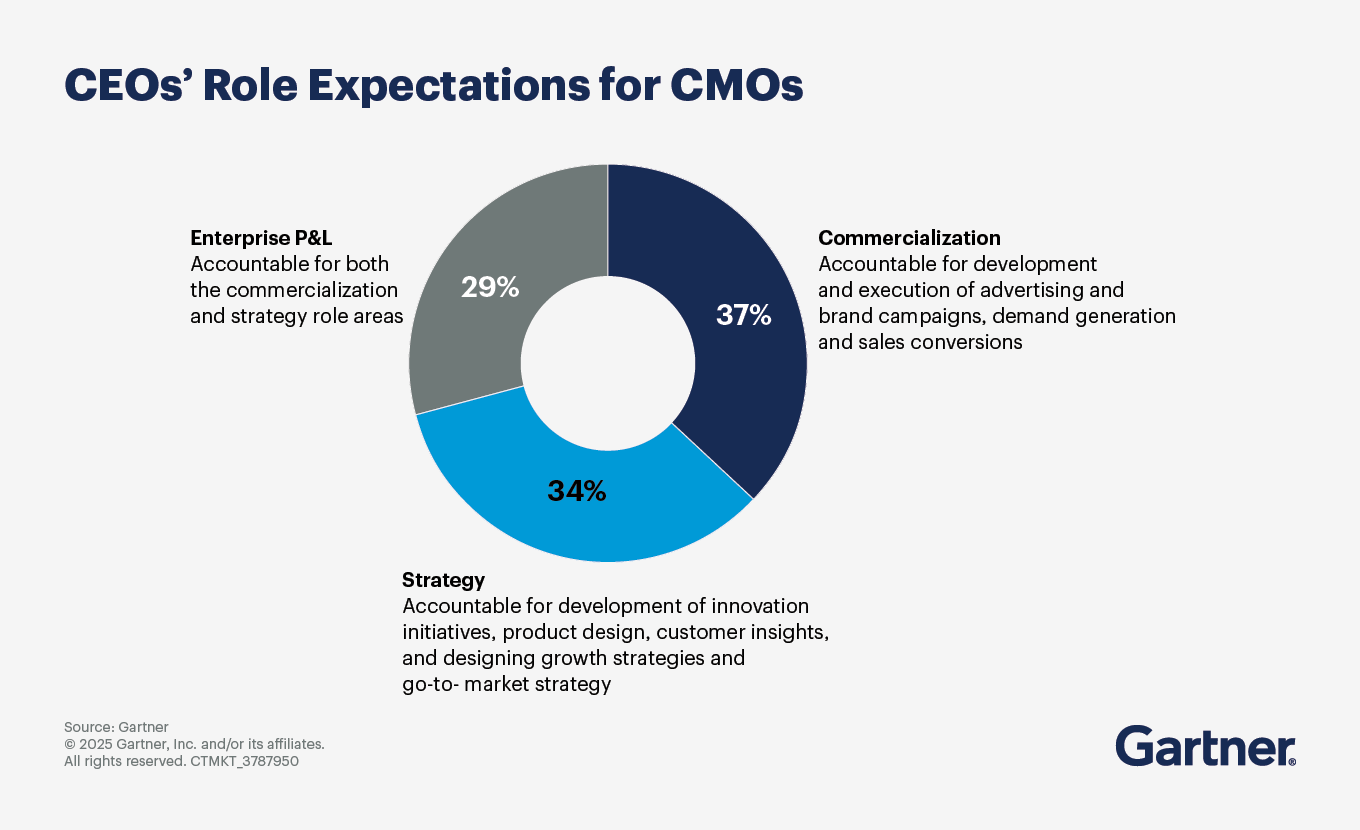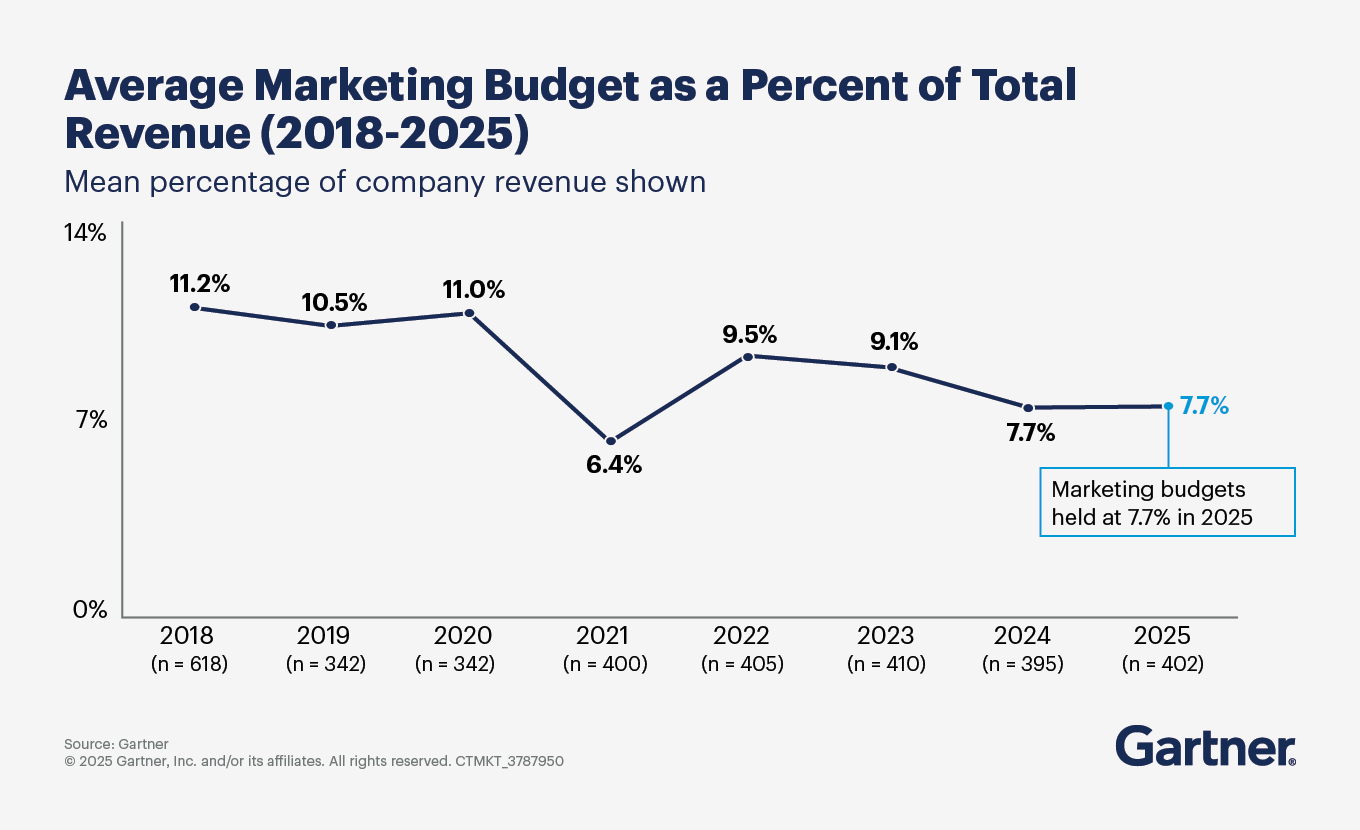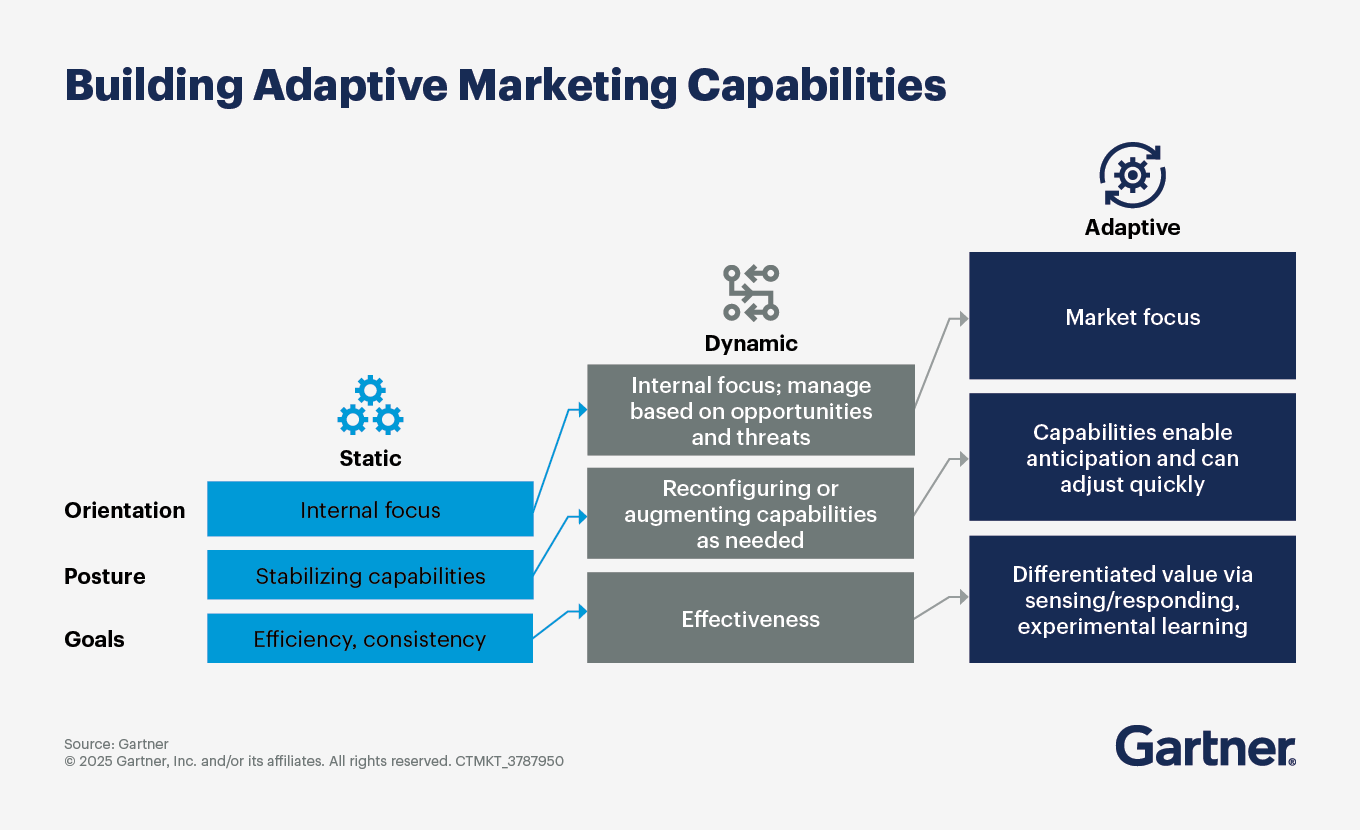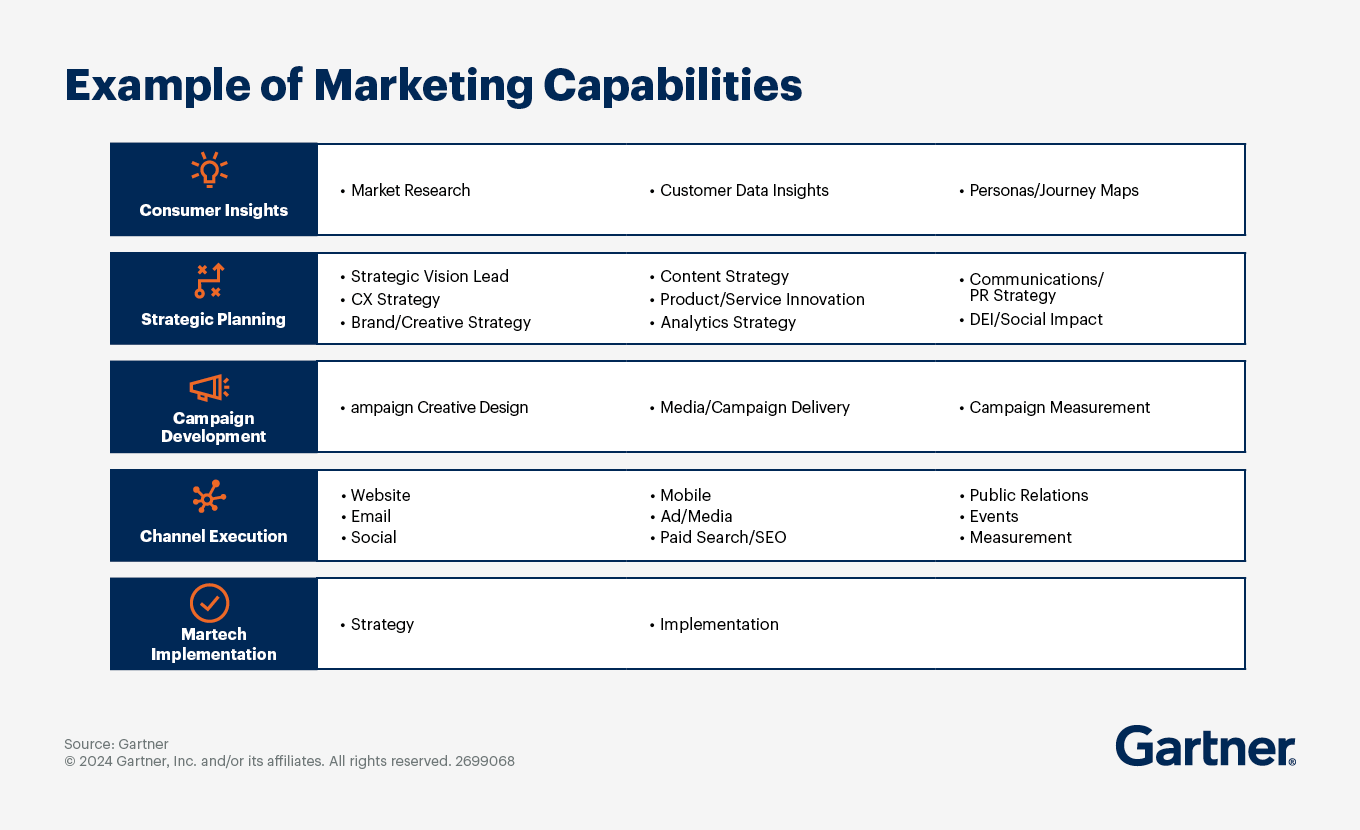Learn how CMOs can leverage effective marketing strategy practices to drive growth and achieve lasting success.
- Gartner client? Log in for personalized search results.
5 Key Ways to Create an Effective Marketing Strategy

Create a marketing strategy that connects activities to enterprise goals
An effective marketing strategy is more than a plan — it’s a discipline that aligns every marketing activity with enterprise objectives, and translates your long-term vision into actionable, measurable steps. Download this marketing strategy planning guide to:
Build a clear, measurable marketing strategy plan that connects marketing activities directly to enterprise goals
Leverage tools and templates that help you translate strategic vision into daily operations
Demonstrate marketing’s value by measuring and communicating impact to key stakeholders
See Gartner research in action at our marketing conferences and events.
The core components of a marketing strategy
The most effective marketing strategy is built for a dynamic environment to drive the business forward.
Marketing Strategy
Marketing Spend
Strategic KPIs
Capabilities
Channels
Marketing Mix
Build resilient marketing strategies aligned to enterprise goals
CMOs now operate in an era of less, where persistent constraints and heightened scrutiny demand a fundamental shift in approach. Success means moving past “doing more with less” to a model where marketing proves its value — connecting each initiative to enterprise goals, bridging long-term vision to short-term action and treating strategy as an ongoing discipline. In this environment, resilience comes from clear priorities, greater productivity and visible impact across the business.
Clarify and establish expectations of marketing’s role
Understanding and meeting the CEO’s expectations for your role and responsibilities are foundational to making marketing’s value visible and measurable. Before you begin strategy development, reinforce agreement on clear areas of marketing accountability with your CEO, executive peers and other key stakeholders — ensuring that every marketing activity is purposefully connected to enterprise goals.
Avoid guesswork and inflated expectations by establishing what marketing will be held accountable for with your CEO. Typically, these include:
Commercialization. Marketing is accountable for developing and executing advertising and brand campaigns, demand generation and sales conversions.
Strategy. Marketing is accountable for innovation initiatives, product design, customer insights, and designing growth strategies and go-to-market strategy.
Enterprise profit and loss (P&L). Marketing is accountable for both the commercialization and strategy roles.

Draw clear connections between high-level goals and low-level marketing tactics
A compelling marketing strategy bridges the gap between your long-term vision and the short-term activities that drive daily execution. Avoid creating strategic plans that are simply to-do lists. Instead, ensure every tactic is purposefully aligned with enterprise objectives, so stakeholders can see how marketing’s day-to-day work advances both immediate business needs and the broader organizational vision.
Reduce, protect and invest to drive growth and efficiency
CMOs face a complex environment following waves of disruption over the past several years, and for many enterprises, the days of double-digit budgets are a thing of the past. But despite the turbulence, marketing budgets have leveled off between 2024 and 2025, with the mean average budget remaining steady at 7.7% of company revenue.
Flat growth is both good news and bad news for CMOs. Although the postpandemic budget decline has halted, marketing spending has stabilized at a rate that many CMOs feel is insufficient to deliver on their strategic ambitions. Even industries with strong initial budgets in 2025 may face shifting allocations as external factors evolve. To thrive, CMOs must make the connection between marketing investments and enterprise outcomes explicit — ensuring that every spending decision supports both the long-term vision and the short-term activities that drive business value.
For marketing, that means assessing your spend in key areas such as agencies, media, martech, operations, digital commerce, campaigns, marketing analytics and projects — exploring how each supports (or hinders) the customer journey and influences business revenue. Consider what programs actively create marketing value versus those that merely support it.
These essential steps should be part of your marketing spend playbook:
Step 1: Benchmark your budgets to identify how your current budget and spending stack up against peers and competitors.
Step 2: Build your understanding of the changing behaviors of your customers and consumers. Build your voice-of-the-customer (VoC) capabilities to track how economic uncertainty is impacting your customers.
Step 3: Shore up your scenario-planning capabilities to build agile, adaptive marketing strategies.

Step 4: Make an assertive case for the value of marketing investments. Invest in marketing because it’s essential for delivering results today and keeping your brands top of mind as buying cycles elongate and spending power is challenged. It also maximizes the chances of accelerating out of tomorrow’s economic headwinds. Rather than accept that cuts are inevitable, make a confident and assertive case for strong and continued investment.
Step 5: Cut marginal marketing costs. Build a cost management plan that balances potential fiscal benefits with risks.
Step 6: Refocus your investments in media, agencies and technology. Identify the investments across marketing’s operating model that enable you to deliver efficiency today and growth tomorrow.
For more on marketing spend, download: Marketing Cost Optimization Framework
Define the performance metrics that link your marketing strategy to execution
Strategic KPIs are the essential bridge between the long-term vision for marketing and the short-term actions that drive daily execution. With aligned operational metrics, CMOs can show how marketing contributes to business goals, justify investments and ensure that every activity is both purposeful and measurable.
A key area of focus is marketing operations (MarOps), which receives about 9% of the CMO’s budget for programs and operational areas. Over a third of CMOs plan to increase that spending — and as they do, scrutiny over what demonstrates success will intensify.
But gaps often occur in measuring the effectiveness of MarOps efforts. To continue to increase budget and remain relevant, MarOps must be able to:
Measure and demonstrate progress against performance goals
Leverage that progress data to inform forward-looking optimization decisions
Focus on 4 KPIs to guide operational decisions and improvements
Most marketing organizations have yet to universally adopt marketing work management systems, but lack of data or imperfect data should not delay establishing productivity baselines. The time to start measuring is now.
Focus on these four operational KPIs:
Capacity. To forecast and plan for upcoming work, start by creating an inventory of capabilities you want to plan for. Capabilities are not roles, but specific skills or skill groupings. For example, capacity for “copywriting” may include not just copywriters, but anyone who does copywriting, like a social manager. Then calculate a baseline measure for capacity by multiplying the number of people with the capability by the amount of time these resources are available to work on the project (measured as a percentage of total time available). Eventually, you’ll want to add other metrics to the baseline, such as focused work time versus time spent on administrative tasks, or employee engagement versus burnout rates.

- Timeliness. To measure marketing’s ability to deliver within committed time frames, establish a baseline measure by answering the question, “How much work was delivered when it was promised?” or “What is the team’s ability to meet preset timelines?” Calculate the answers by looking at the start and completion dates of the work, or at the request date and completion date. As you progress with your measurement, you’ll want to establish additional time stamps to measure the velocity of work with a goal of demonstrably improving delivery times.
- Alignment. To measure marketing’s ability to deliver work that supports both marketing strategy and overall business goals, start with your most available resource: access to stakeholders. Capture stakeholder feedback and responses through surveys and interviews, asking questions such as: Is marketing meeting business needs? Is marketing analytics delivering against top-level prioriti
- Quality. Measure marketing’s ability to meet or exceed standards and expectations when delivering customer-facing collateral, by analyzing incoming change requests. Establish a baseline by creating an internal checklist with quality standards for items like data accuracy, clear calls to action and alignment to brand messaging. As you begin to see patterns, expand on the baseline by seeking to understand the underlying drivers of change orders and barriers to delivering quality work.
Build capabilities that enable agile execution
Ninety-four percent of CMOs say that translating enterprise strategic directives into actionable plans for marketing is a challenge. CMOs often respond to short-term, execution-oriented needs by restructuring or hiring. But these measures fail to make a significant impact, and often lead to further changes down the line.
To break the cycle of reactive restructuring and talent planning, build adaptive marketing capabilities. When business context and goals shift, building adaptive capabilities enables you to get ahead of strategic drivers of change with more agile execution.
Adaptive capabilities have a market focus. They enable the organization to anticipate and quickly adjust to opportunities and threats, whether external or internal. Rather than pursuing continuous, incremental improvement in the hope of keeping up, adaptive capabilities focus on seizing opportunities that will help you surpass the competition.
CMOs with adaptive capabilities are able to sense and respond to how customers and competitors are changing. Rather than sticking to known advantages, they look at what customers need regardless of marketing’s current ability to execute. They are confident that the required skills can be learned and the capabilities developed.
Identify capability gaps
Insights and analytics that synthesize data from disparate sources inside and beyond the organization, such as market intelligence, trendspotting and voice of the customer (VoC)
Go-to-market strategy that makes sense of the opportunities and threats facing the business in collaboration with cross-functional stakeholders
Innovation that identifies programs, projects and products that can create new value for the customer and business

Growth hacking that formulates hypotheses and develops tests to validate assumptions and refine understanding
- Operational agility that mobilizes resources (people, process, data and technology) for novel capabilities needed for value delivery and market shaping
These capabilities do not all need to be resourced within marketing. Instead, focus on driving the capability-building process, not only within the function, but also with cross-functional collaborators. Adaptive capabilities overcome silos that impede a coherent customer view and slow decision making in order to inform strategy with deep market insights.
Optimize your marketing channel strategy with a holistic approach
Marketing channels, both online and offline, play a vital role in spreading the word about a brand and reaching potential customers. Marketing leaders realize the importance of a clear and cohesive cross-channel experience, but too often they struggle to break their marketing channel strategies out of organizational silos.
Our research shows that across industries, customers reported using an average of four unique channels throughout their interaction with a brand, such as a company’s website, email, SMS and social media, during their customer buying journey. To build an effective channel portfolio, successful brands first gather insights to identify target customer groups and establish key leadership priorities. These insights include:
Top marketing goals and how they can be supported across channels
Personas or segments that define the brand’s target customer
Brand research on customer sentiments and economic opportunities or threats
Existing customer journey map(s)
Ideal customer actions across the journey that would help meet the brand’s objectives
A thorough understanding of the target audience, business goals and available resources enables a brand to establish its overarching strategy across channels versus at an individual channel level. An optimized channel strategy should:
Put the customer first. Brands that consider their target customers’ channel preferences and how they use those channels are less likely to invest in experiences that don’t align with customer expectations.
Factor in existing channel strategies. Achieving the right channel mix requires an honest look at a brand’s experiences to ensure they drive ideal customer actions. Successful marketers take an active approach to fine-tuning versus a “fix and forget” approach.
Prioritize. Every organization has its unique resource constraints. Having a thorough understanding of customer needs and how the existing channel strategy is (or isn’t) performing will help ensure that investments fuel the channels most likely to drive returns.
From a spend perspective, in 2025, digital channels dominate the media mix. CMOs allocated nearly two-thirds of their channel budget to digital, with 69% of all digital spend pushed to paid channels.
Improve performance, optimize investments and quantify marketing’s impact
CMOs are under tremendous pressure to prove the impact of marketing. But incomplete data across an ever-growing mix of marketing activities, channels, devices and touchpoints can lower trust in their performance metrics.
Marketing mix modeling (MMM) is a technique used to evaluate how the different elements of a marketing mix affect overall performance. By using MMM to identify which tactics have the strongest impact, CMOs can make data-driven decisions about their marketing strategies, track the return on marketing investments, allocate resources more effectively and optimize their tactics to achieve their objectives successfully.
Marketers still struggle to answer foundational questions about the impact of marketing on the business. The goal of MMM is to determine the incremental impact of marketing activities and use those findings to answer strategic marketing questions. The details of the modeling approach differ, but most forms use aggregate (not user-level) data. As a result, MMM can consider a wide range of channels and external influences, including:
Digital media (e.g., social media and banner ads)
Traditional media (e.g., broadcast television, out-of-home and radio)
Company factors that can impact conversions (e.g., inventory levels, staffing and geographic footprint)
Market forces (e.g., relative price, competitive media spending and share of voice)
External factors (e.g., weather, seasonality, economic conditions and consumer confidence)
MMM has a long history, and it continues to evolve. If you looked at marketing mix a decade ago and dismissed it as “insights only at the channel level” or “results only updated quarterly,” you may want to reconsider. Recent improvements in MMM include faster turnaround times, greater depth of insights and more prescriptive recommendations.
In short, successful CMOs use MMM to ease challenges and uncertainty around marketing’s growing complexity.
To maximize the effectiveness of your marketing mix model, adopt these three practices:
Prioritize insights. Rank the outputs that will bring the most value from your marketing mix model. Then lean into scenario planning and model validation to improve program effectiveness.
Build trust through validation. Our research showed that marketing leaders with higher trust in their MMM were more likely to describe insights delivered by marketing analytics as “essential to our organization’s success.” But MMM findings often challenge conventional wisdom. Treat your marketing mix model as a credible suggestion, not a mandate.
Plan and optimize. Engage in what-if scenario planning to create resilient, higher-performing marketing plans over time.
Attend a Conference
Join Gartner experts and your peers to accelerate growth
Join CMOs and marketing executives to learn how to navigate emerging trends and challenges. From peer-led sessions to analyst one-on-ones, you'll leave ready to tackle your mission-critical priorities.
Gartner Marketing Symposium/Xpo™
Denver, CO

Related resources
Marketing strategy FAQs
What is a marketing strategy?
A marketing strategy is a plan designed to achieve a defined marketing goal, generally to reach a particular audience of consumers and convert them into customers.
What are the benefits of a marketing strategy?
A marketing strategy offers numerous benefits:
Establishes clear direction and goals, ensuring all efforts are aligned with business objectives
Helps identify target audiences and tailors messages to their needs, increasing engagement and conversion rates
Enables efficient resource allocation, maximizing ROI
Fosters consistency in branding and messaging, building stronger customer relationships
Allows for better measurement and analysis of marketing efforts, leading to continuous improvement and success
Why is a marketing strategy important?
A marketing strategy is important because it defines what the function will do to help the enterprise be successful — how it plans to compete and win in its chosen markets or deliver expected services to consumers and fulfill its public mission.
What tools can help execute a marketing strategy?
Two helpful tools for executing a successful marketing strategy are a performance roadmap that connects short-term priorities with long-term outcomes, and a skills and tools assessment that includes a plan to close potential gaps in execution.
How do I measure the success of my marketing strategy?
One of the best tools for measuring marketing strategy success is the use of KPIs — specific, numerical marketing metrics that measure progress toward a defined goal within marketing channels. Examples of marketing KPIs include: unique website visitors, cost per lead, form conversion rate, marketing-qualified leads generated, marketing-generated sales-qualified leads, cost per sales-qualified lead, closing rate, customer retention, and marketing ROI.
How often should a marketing strategy be updated?
Traditionally, marketing strategies are revisited every 18 to 36 months. However, in today’s fast-changing environment, it’s essential to shift from treating strategy as a set of deliverables to treating strategy as an ongoing discipline. Pay close attention to internal and external factors that could impact your strategy and your team’s ability to execute. Revisit your strategy regularly — not just on a fixed schedule — to ensure you can pivot quickly when needed.
Drive stronger performance on your mission-critical priorities.